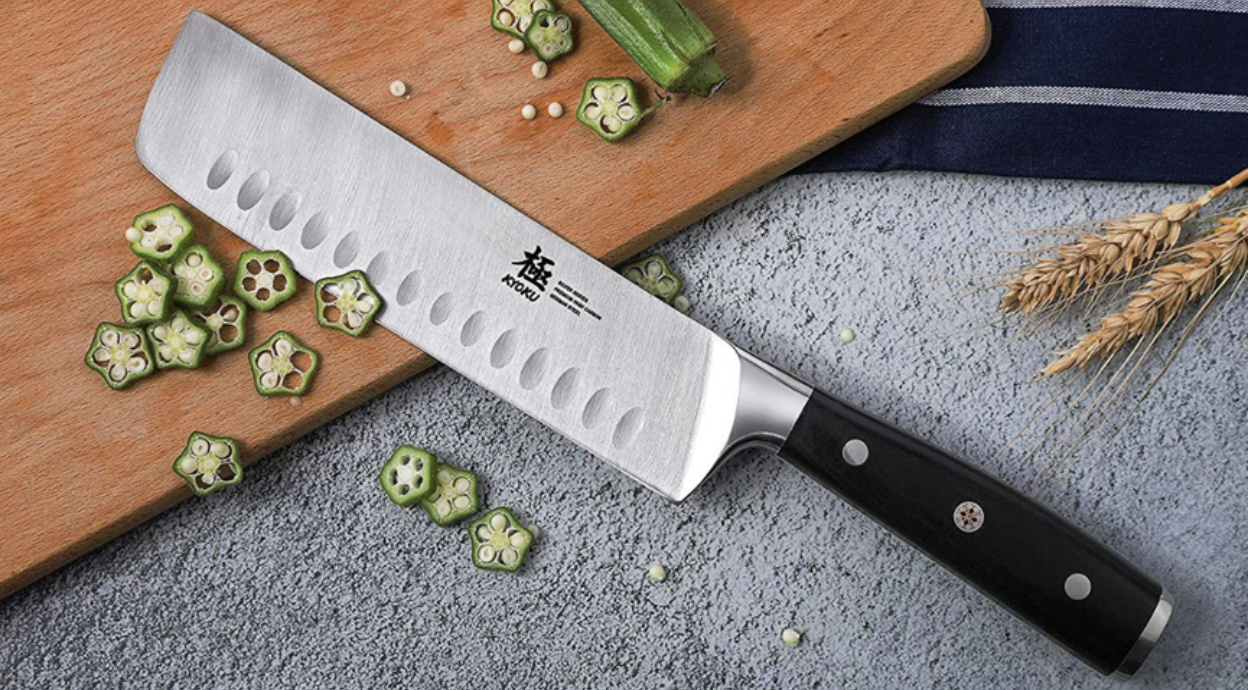
Introduction
When it comes to slicing, dicing, and chopping vegetables with precision and ease, the Nakiri knife stands out as an essential tool in any kitchen. This traditional Japanese knife is specially designed to handle all types of vegetables, offering clean and efficient cuts with minimal effort. Whether you’re a home cook, a professional chef, or an enthusiast of Japanese cuisine, the Nakiri knife can elevate your vegetable preparation to a whole new level.
What is a Nakiri Knife?
The Nakiri knife is a specialized Japanese vegetable knife that has been a staple in Japanese kitchens for centuries. It features a rectangular blade shape and a straight edge, making it perfect for precise, downward cuts. Unlike Western-style knives that use a rocking motion, the Nakiri is designed for a push-cutting technique, allowing for effortless slicing of even the most delicate vegetables.
Key Features of a Nakiri Knife:
- Straight, flat edge – Ensures full contact with the cutting board, preventing uneven cuts.
- Thin, lightweight blade – Reduces resistance for smooth, effortless slicing.
- Double-beveled edge – Makes it easy to use for both right- and left-handed users.
Nakiri vs. Other Japanese Knives:
- Nakiri vs. Santoku – Santoku knives have a more curved blade, making them suitable for general-purpose use, whereas Nakiri knives are designed specifically for vegetables.
- Nakiri vs. Gyuto – Gyuto knives resemble Western chef’s knives and are versatile, but they lack the specialized design of a Nakiri for vegetable cutting.
- Nakiri vs. Usuba – The Usuba is a single-beveled knife used by professionals, whereas the Nakiri is easier to use and maintain.
Why Choose a Nakiri Knife?
A Nakiri knife offers numerous advantages over traditional Western knives when it comes to preparing vegetables.
- Precision Cutting – The flat blade ensures complete cuts with no rocking motion, leading to uniform slices and cubes.
- Efficiency – The straight edge allows for quick chopping, making food prep faster and smoother.
- Preserves Ingredient Integrity – Unlike heavy-duty knives that can crush delicate ingredients, the Nakiri glides through vegetables cleanly without damaging them.
- Ideal for Large Batches – If you frequently cook meals with lots of vegetables, a Nakiri knife will make the process much easier.
How to Use a Nakiri Knife Properly
To get the best results from your Nakiri knife, it's important to use the correct techniques.
Cutting Techniques:
- Push-Cutting – Move the blade straight down and forward, rather than using a rocking motion.
- Chopping – Use short, controlled movements for even slices.
- Julienne & Dice – The flat blade makes it easy to create consistent matchsticks or cubes.
Proper Grip & Hand Placement:
- Hold the handle firmly but comfortably, with your thumb and index finger gripping the blade near the bolster for maximum control.
- Use your non-cutting hand to guide the vegetable, keeping fingertips tucked under in a “claw” position for safety.
Common Mistakes to Avoid:
- Rocking the blade instead of using a straight push-cut.
- Applying too much force – the thin blade should glide effortlessly.
- Using the Nakiri for tasks it’s not designed for, like cutting meat or bones.
Choosing the Right Nakiri Knife
When selecting a Nakiri knife, there are a few important factors to consider:
Key Features to Look For:
- Blade Material:
- Stainless steel – Rust-resistant and easy to maintain.
- High-carbon steel – Sharper and more durable but requires more care.
- Handle Type:
- Wood – Traditional and comfortable but requires maintenance.
- Composite – Low-maintenance and durable.
- Metal – Modern design with extra durability.
- Weight & Balance: A well-balanced knife reduces hand fatigue and improves control.
Recommended Nakiri Knives: Kyoku Nakiri Knives
Known for their high-quality craftsmanship, Kyoku Nakiri knives offer exceptional sharpness, durability, and a comfortable grip. With a beautiful blend of traditional Japanese design and modern technology, Kyoku knives are ideal for people looking to elevate their vegetable cutting skills.
Caring for Your Nakiri Knife
Proper maintenance will keep your Nakiri knife in top condition for years to come.
Cleaning & Storage Tips:
- Hand Wash Only – Avoid dishwashers, as the harsh environment can damage the blade.
- Dry Immediately – Prevents rust and prolongs the life of the knife.
- Use a Knife Guard or Magnetic Strip – Protects the blade from damage.
- Use a Non-Toxic Cutting Board – To preserve the sharpness of your Nakiri knife, it's important to use a cutting board made from materials that won’t dull the blade. A non toxic cutting board is a great choice for keeping both your knife and your food safe.
Sharpening Techniques:
- Use a whetstone for sharpening (medium grit for regular maintenance, fine grit for a polished edge).
- Honing rods help maintain the edge between sharpening sessions.
- Avoid cheap pull-through sharpeners, as they can damage the knife.
Conclusion
A Nakiri knife is an excellent investment for anyone who wants to improve their vegetable-cutting skills. With its sharp, precise blade and efficiency in chopping, it’s the perfect tool for preparing a wide variety of ingredients with ease. By choosing the right Nakiri knife, using proper cutting techniques, and maintaining it well, you can enhance your cooking experience and enjoy the benefits of this exceptional Japanese knife.
